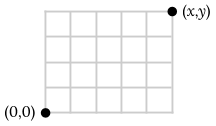My house is just a few blocks away from a cool bar/restaurant/bowling alley/theater in Minneapolis. The part of Minneapolis where I live is laid out like a grid. For the sake of argument, let's imagine my house as the origin, and the bar $x$ blocks east and $y$ blocks north, at the corner $(x,y)$. We're only going to consider situations where the bar is north or east of me; that is, $x, y \ge 0$.

So let's say I want to walk to the bar, following the street grid. I only ever walk north or east, one block at a time. Even under this constraint, I still have lots of choices: I could walk north until I'm even with the bar (at $(0,y)$) and then walk east, or I could walk east to $(x,0)$ and then north, or I could kinda zig-zag up and over. In all, there are
$$\frac{(x+y)!}{x!y!}$$
different choices of unique paths from my house to the bar. (We'll learn how to come up with this formula later in the course; for now, you'll have to take my word for it.) Try this formula out on a few small examples and convince yourself that it's correct. (Keep in mind that $0! = 1$.)
Then, for your solution to this problem, prove that the above formula for the number of paths is correct for all $x,y \ge 0$.
Here are a few hints:
Think about a recursive definition of a path from my house to the point $(x,y)$. Pay careful attention to the cases where one coordinate is 0 but not the other!
In a lot of problems that involve recursive or inductive reasoning, you have a somewhat free choice of base cases. Think about it explicitly: what should the base case (or cases) be for this problem?
It might be helpful to think of this problem in terms of a function $H(x,y)$ that evaluates to the number of distinct paths from my house to a bar at $(x,y)$. How could you compute the value of $H(x,y)$ just by doing some very simple math on the values of $H$ evaluated for a small number of other positions?
-
Remember that a factorial is just a product of positive integers up to some stopping point. You can always “pick off the top” from such a product:
$$ \begin{align} n! &= n \cdot (n-1) \cdot (n-2) \cdot \ldots \cdot 2 \cdot 1 \\ &= n \cdot \left[ (n-1) \cdot (n-2) \cdot \ldots \cdot 2 \cdot 1 \right] \\ &= n \cdot (n-1)! \end{align} $$
For the same reason, $(n+1)! = (n+1) \cdot n!$.
You can also always “stack one more on top”; this is just reading the above derivation from the bottom up:
$$ \begin{align} n \cdot (n-1)! &= n \cdot \left[ (n-1) \cdot (n-2) \cdot \ldots \cdot 2 \cdot 1 \right] \\ &= n \cdot (n-1) \cdot (n-2) \cdot \ldots \cdot 2 \cdot 1 \\ &= n! \end{align} $$
And, of course, $(n+1) \cdot n! = (n+1)!$.